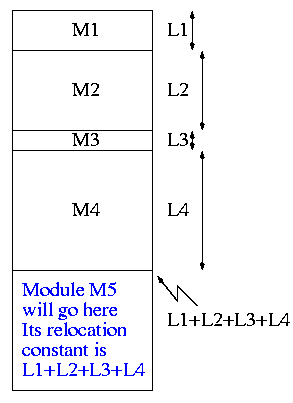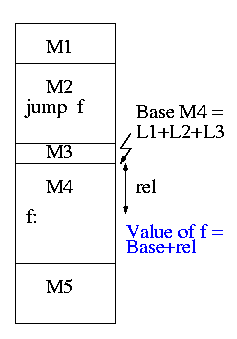Operating Systems
2000-01 Fall
M 5:00-6:50
Ciww 109
Allan Gottlieb
gottlieb@nyu.edu
http://allan.ultra.nyu.edu/~gottlieb
715 Broadway, Room 1001
212-998-3344
609-951-2707
email is best
======== START LECTURE #1
========
Administrivia
Web Pages
There is a web page for the course. You can find it from my home page.
- Can find these notes there.
Let me know if you can't find it.
- They will be updated as bugs are found.
- Will also have each lecture available as a separate page. I will
produce the page after the lecture is given. These individual pages
might not get updated.
Textbook
Text is Tanenbaum, "Modern Operating Systems".
- Available in bookstore.
- We will do part 1, starting with chapter 1.
A Grade of ``Incomplete''
It is university policy that a student's request for an incomplete
be granted only in exceptional circumstances and only if applied for
in advance. Of course the application must be before the final exam.
Computer Accounts and Mailman mailing list
- You are entitled to a computer account, get it.
- Sign up for a Mailman mailing list for the course.
http://www.cs.nyu.edu/mailman/listinfo/g22_2250_001_fl00
- If you want to send mail to me, use gottlieb@nyu.edu not
the mailing list.
- You may do assignments on any system you wish, but ...
- You are responsible for the machine. I extend deadlines if
the nyu machines are down, not if yours are.
- Be sure to upload your assignments to the
nyu systems.
- If somehow your assignment is misplaced by me or a grader,
we need a to have a copy ON AN NYU SYSTEM
that can be used to verify the date the lab was completed.
- When you complete a lab (and have it on an nyu system), do
not edit those files. Indeed, put the lab in a separate
directory and keep out of the directory. You do not want to
alter the dates.
Homework and Labs
I make a distinction between homework and labs.
Labs are
- Required
- Due several lectures later (date given on assignment)
- Graded and form part of your final grade
- Penalized for lateness
Homeworks are
- Optional
- Due the beginning of Next lecture
- Not accepted late
- Mostly from the book
- Collected and returned
- Can help, but not hurt, your grade
Upper left board for assignments and announcements.
Interlude on Linkers
Originally called linkage editors by IBM.
This is an example of a utility program included with an
operating system distribution. Like a compiler, it is not part of the
operating system per se, i.e. it does not run in supervisor mode.
Unlike a compiler it is OS dependent (what object/load file format is
used) and is not (normally) language dependent.
What does a Linker Do?
Link of course.
When the assembler has finished it produces an object
module that is almost runnable. There are two primary
problems that must be solved for the object module to be runnable.
Both are involved with linking (that word, again) together multiple
object modules.
- Relocating relative addresses.

- Each module (mistakenly) believes it will be loaded at
location zero (or some other fixed location). We will
use zero.
- So when there is an internal jump in the program, say jump to
location 100, this means jump to location 100 of the current
module.
- To convert this relative address to an absolute
address, the linker adds the base address of the module
to the relative address. The base address is the address at which
this module will be loaded.
- Example: Module A is to be loaded starting at location 2300 and
contains the instruction
jump 120
The linker changes this instruction to
jump 2420
- How does the linker know that Module M5 is to be loaded starting at
location 2300?
- It processes the modules one at a time. The first module is
to be loaded at location zero. So the relocating is trivial
(adding zero). We say the relocation constant is zero.
- When finished with the first module (say M1), the linker knows
the length of M1 (say that length is L1).
- Hence the next module is to be loaded starting at L1, i.e.,
the relocation constant is L1.
- In general the linker keeps track of the sum of the lengths of
all the modules it has already processed and this is the location
at which the next module is to be loaded.
- Resolving external references.

- If a C (or Java, or Pascal) program contains a function call
f(x)
to a function f() that is compiled separately, the resulting
object module will contain some kind of jump to the beginning of
f.
- But this is impossible!
- When the C program is compiled. the compiler (and assembler)
do not know the location of f() so there is no way it
can supply the starting address.
- Instead a dummy address is supplied and a notation made that
this address needs to be filled in with the location of
f(). This is called a use of f.
- The object module containing the definition of f() indicates
that f is being defined and gives its relative address (which the
linker will convert to an absolute address). This is called a
definition of f.
The output of a linker is called a load module
because it is now ready to be loaded and run.
To see how a linker works lets consider the following example,
which is the first dataset from lab #1. The description in lab1 is
more detailed.
The target machine is word addressable and has a memory of 1000 words,
each consisting of 4 decimal digits. The first (leftmost) digit is
the opcode and the remaining three digits form an address.
Each object module contains three parts, a definition list, a use
list, and the program text itself. Each definition is a pair (sym,
loc). Each use is a pair (sym, loc). The address in loc points to
the next use or is 999 to end the chain.
For those text entries that do not form part of a use chain a fifth
(leftmost) digit is added. If it is 8, the address in the word is
relocatable. If it is 0 (and hence omitted), the address is absolute.
Sample input
1 xy 2
1 z 4
5 81234 5678 2999 88888 7002
0
1 z 3
6 88888 1999 1001 3002 81002 1234
0
1 z 1
2 81234 4999
1 z 2
1 xy 2
3 8000 1999 2001
I will illustrate a two-pass approach: The first pass simply
produces the symbol table giving the values for xy and z (2 and 15
respectively). The second pass does the real work (using the values
in the symbol table).
It is faster (less I/O) to do a one pass approach, but is harder
since you need ``fix-up code'' whenever a use occurs in a module that
precedes the module with the definition.
xy=2
z=15
+0
0: 81234 1234+0=1234
1: 5678 5678
2: xy: 2999 ->z 2015
3: 88888 8888+0=8888
4: ->z 7002 7015
+5
0 88888 8888+5=8893
1 1999 ->z 1015
2 1001 ->z 1015
3 ->z 3002 3015
4 81002 1002+5=1007
5 1234 1234
+11
0 81234 1245
1 ->z 4999 4015
+13
0 8000 8000
1 1999 ->xy 1002
2 z:->xy 2001 2002
The linker on unix is mistakenly called ld (for loader), which is
unfortunate since it links but does not load.
Lab #1 Implement a linker. The specific
assignment is detailed on the sheet handed out in in class and is due
in three weeks 16 February. The content of the handout is available
on the web as well (see the class home page).
End of Interlude on Linkers
Chapter 1. Introduction
Homework: Read Chapter 1 (Introduction)
Levels of abstraction (virtual machines)
- Software (and hardware, but that is not this course) is often
implemented in layers.
- The higher layers use the facilities provided by lower layers.
- Alternatively said, the upper layers are written using a more
powerful and more abstract virtual machine than the lower layers.
- Alternatively said, each layer is written as though it runs on the
virtual machine supplied by the lower layer and in turn provides a more
abstract (pleasent) virtual machine for the higher layer to run on.
- Using a broad brush, the layers are.
- Scripts (e.g. shell scripts)
- Applications and utilities
- Libraries
- The OS proper (the kernel)
- Hardware
- The kernel itself is itself normally layered, e.g.
- ...
- Filesystems
- Machine independent I/O
- Machine dependent device drivers
- The machine independent I/O part is written assuming ``virtual
(i.e. idealized) hardware''. For example, the machine independent I/O
portion simply reads a block from a ``disk''. But
in reality one must deal with the specific disk controller.
- Often the machine independent part is more than one layer.
- The term OS is not well defined. Is it just the kernel? How
about the libraries? The utilities? All these are certainly
system software but not clear how much is part of the OS.
1.1: What is an operating system?
The kernel itself raises the level of abstraction and hides details.
For example a user (of the kernel) can write to a file (a concept not
present in hardware) and ignore whether the file resides on a floppy,
a CD-ROM, or a hard magnetic disk
The kernel is a resource manager (so users don't conflict).
How is an OS fundamentally different from a compiler (say)?
Answer: Concurrency! Per Brinch Hansen in Operating Systems
Principles (Prentice Hall, 1973) writes.
The main difficulty of multiprogramming is that concurrent activities
can interact in a time-dependent manner, which makes it practically
impossibly to locate programming errors by systematic testing.
Perhaps, more than anything else, this explains the difficulty of
making operating systems reliable.

